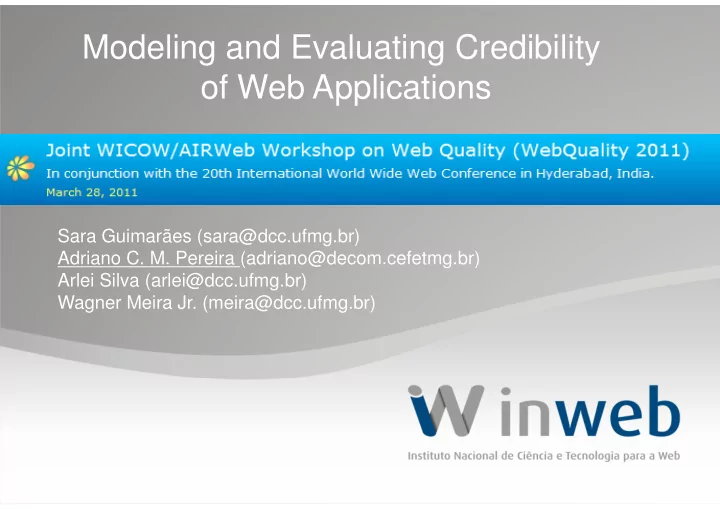

Modeling and Evaluating Credibility of Web Applications Sara Guimarães (sara@dcc.ufmg.br) Adriano C. M. Pereira (adriano@decom.cefetmg.br) Adriano C. M. Pereira (adriano@decom.cefetmg.br) Arlei Silva (arlei@dcc.ufmg.br) Wagner Meira Jr. (meira@dcc.ufmg.br)
AGENDA • Some brief words… • Introduction • Framework Definition – Credibility Rank; • Case Study; • Case Study; • Conclusion and Ongoing work. 2
Who am I? • Professor in Computer Engineering; • Member of Brazilian National Institute of Science and Technology for the Web (INWeb); • Brazil: • • The fifth largest country by geographical area; The fifth largest country by geographical area; • The fifth most populous country in the world. The world's 8 th largest economy; • • Has 26 states and a Federal District. • Minas Gerais: • SouthEast; • Close to São Paulo and Rio de Janeiro. • WWW’2013: will be in Rio de Janeiro, Brazil. 3
WWW’2013 – Rio de Janeiro, Brazil InWeb . Instituto Nacional de Ciência e Tecnologia para a Web
Introduction - Credibility • From the Latin credibilitate , credibility means the “quality of what is credible or believable”. • Thus, we can state that credibility is strongly related to the reliability of an assessment, trust, and also to the reliability of an assessment, trust, and also with the knowledge that one has to make value judgments. • Our life is made of choices... 5
Introduction - Credibility • CACM’99 (“Credibility and Computing Technology” – Fogg and Tseng, 99 - Stanford). • Credibility can be defined as believability. • Credible people are believable people; • Credible people are believable people; • credible information is believable information; • In fact, some languages use the same word for these two English terms. 6
Introduction - Credibility • Choices: • Buy A or B? • Option C or D? • Can I trust on Person X? • Can I trust on Person X? • Credibility is an extremely important concept in everyday life! 7
Introduction - Credibility • A scale: • The credibility of “something” can be mapped to a scale, like a ranking showing how you can believe (trust) in this “something”. 8
Introduction - Credibility • Main motivation : Need to acquire information to enforce the credibility on the use of Web applications! Model Credibility Function Web applications (information) 9
Introduction - Credibility • So... The task of evaluating and quantifying Credibility: • Major challenge of this research (number of variables, variables, reliability reliability of of the the information information available, computational challenges); • How to do it?
Framework Definition – Credibility Rank • A new framework for the design and evaluate of credibility models;
Framework Definition – Credibility Rank • A new framework for the design and evaluate of credibility models; • C++ modules; • The proposal is to provide a tool to model and • The proposal is to provide a tool to model and evaluate different credibility models;
Framework Definition – Credibility Rank
Case Study – Dataset Description • About the dataset: • An e-market data from de Largest Latin American ISP and content provider (UOL); • Sample • Sample of of some some tens tens of of thousand thousand of of transactions;
Case Study – Dataset Description
Case Study – Dataset Description • Characterization of several attributes that could be Credibility criteria: • Price; • Views; • Views; • Percentage of Positive Qualifications; • Global Score; • Average Negotiated value; • Etc.
Case Study – Methodology • Each attribute can be used to define a function � Credibility Model; • Simple Strategy: • Combine the attributes; • Combine the attributes; • Choosing best k models; and • Continue process until: • N iterations; • Minimum gain at each step. • Exponential possibilities, but fast.
Case Study – Methodology • Evaluation: • Compare to baselines: • Global Score; • % of Positive Feedback; • % of Positive Feedback; • Combination of them. • Compare with SVM-Rank.
Case Study – Methodology • Quality of model: • Probability of receiving negative feedback (focus on some ranking segments); • Graph inclination and Area Under • Graph inclination and Area Under the Curve (AUC); • Credibility Indicator (CI) = 1/AUC. • Ranking: • Top and bottom: most important. • Apply CredibilityRank to evaluate the dataset.
Case Study – Experiments / Results • Credibility Models: Top of the Rank
Case Study – Experiments / Results • Credibility Models: Bottom of the Rank
Case Study – Experiments / Results
Conclusion • Model and evaluate some credibility models (functions) for e-Business ( e-market dataset); • Apply a framework (CredibilityRank) to this actual dataset; dataset; • Compare results with baselines and with a SVM- Rank algorithm; • Top of the rank (most “credible” services / users) and bottom of the rank; • Consider Probability of Negative Feedback as a quality indicator.
Conclusion • The results: • Top of the rank: • 116.8% better than baseline; • 36.4% over the SVM-Rank; • 36.4% over the SVM-Rank; • Bottom of the rank: • 24.6% over the baeline; • 37.8% better than SVM-Rank; • Promising results, but much more to improve; • A good model: not necessarily need many combined attributes;
Conclusion • Ongoing work: • Improve the evaluation / analysis of credibility models (metrics); • New credibility models based on machine • New credibility models based on machine learning and genetic algorithms; • Fraud detection project (e-market / e-payment systems); • Acknowledgements: • INWeb and Brazilian Gov. Agencies; • UOL Inc.
Thank you! Questions? Any suggestions? Adriano C. M. Pereira Federal Center of Technological Education of Minas Gerais. e-mail: adriano@decom.cefetmg.br www.inweb.org.br
Recommend
More recommend